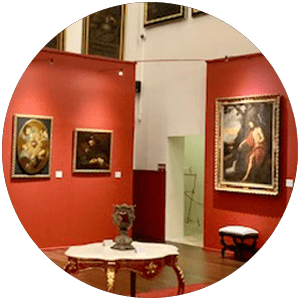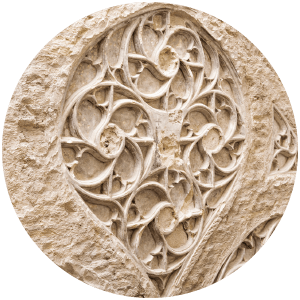This zone belongs to the institutional space of the archbishop’s palace. It includes this floor created in the extension promoted by Archbishop Hernando of Aragon in the 16th century. The whole buildings which were annexed over the centuries since the conquest of Zaragoza in 1118 were regularized with this extension.
This room is the Throne Hall anteroom which displays an official gallery of idealized portraits of Bishops of Zaragoza in the upper zone of its walls, made by Aragonese painter Pablo Rabiella y Díez de Aux. The individual portraits of the first Archbishops of Zaragoza are contemplated above the door which gives access to the walkway.
This zone belongs to the institutional space of the archbishop’s palace. It includes this floor created in the extension promoted by Archbishop Hernando of Aragon in the 16th century. The whole buildings which were annexed over the centuries since the conquest of Zaragoza in 1118 were regularized with this extension.
This room is the Throne Hall anteroom which displays an official gallery of idealized portraits of Bishops of Zaragoza in the upper zone of its walls, made by Aragonese painter Pablo Rabiella y Díez de Aux. The individual portraits of the first Archbishops of Zaragoza are contemplated above the door which gives access to the walkway.

![]()
The work of the three best Aragonese artists from 18th and 19th centuries is collected in this room: José Luzán, Francisco Bayeu y Francisco de Goya. José Luzán was educated in Napoles inside Baroque style. He transmitted this style to Goya and Bayeu in their first years of education when being their master. Francisco Bayeu expounds in his painting the transit from Baroque to Rococo style, with a mastery that consecrated him as court painter in 1767. Francisco de Goya y Lucientes, internationally known, stands out for his genius, being considered precursor of expressive language in 20th century pictorial avant-garde. Monarchs Carlos III and Carlos IV of Spain appear among his main clients.

The work of the three best Aragonese artists from 18th and 19th centuries is collected in this room: José Luzán, Francisco Bayeu y Francisco de Goya. José Luzán was educated in Napoles inside Baroque style. He transmitted this style to Goya and Bayeu in their first years of education when being their master. Francisco Bayeu expounds in his painting the transit from Baroque to Rococo style, with a mastery that consecrated him as court painter in 1767. Francisco de Goya y Lucientes, internationally known, stands out for his genius, being considered precursor of expressive language in 20th century pictorial avant-garde. Monarchs Carlos III and Carlos IV of Spain appear among his main clients.

![]()
From this walkway (room 14), you can see closer the original roof decoration of the 15th century chapel (room 2). To make this decoration, great skill was required: after preparing the relief in plaster, a layer of red soil (Armenian bole) was applied and on this, golden leaves were added which were polished to get a bright gold with red reflections by transparency.

From this walkway (room 14), you can see closer the original roof decoration of the 15th century chapel (room 2). To make this decoration, great skill was required: after preparing the relief in plaster, a layer of red soil (Armenian bole) was applied and on this, golden leaves were added which were polished to get a bright gold with red reflections by transparency.
